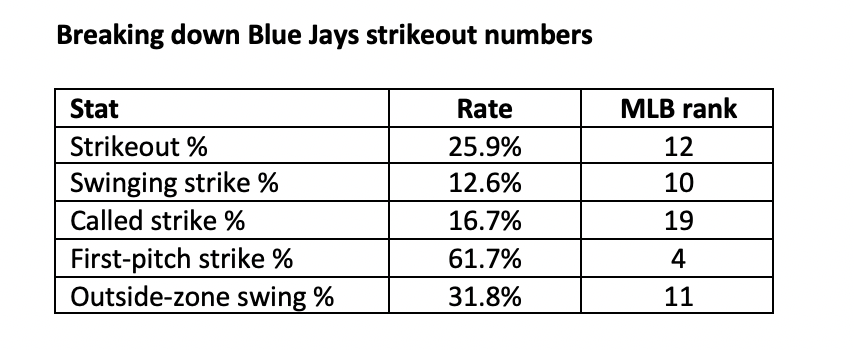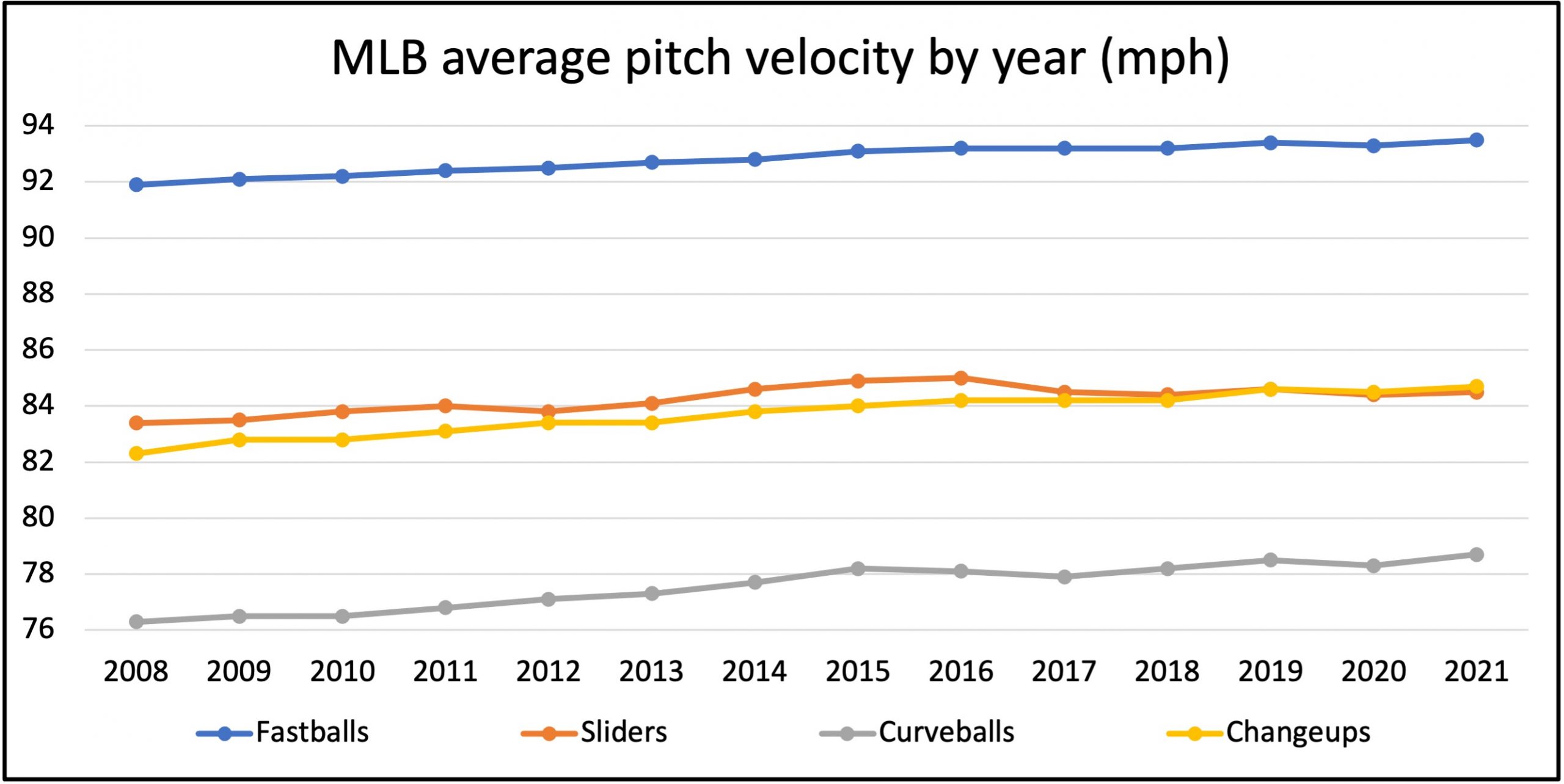Have you seen this? Have you heard about this? The Toronto Blue Jays are striking out too often. They’re up there just swinging away, chasing crap. They just set a franchise record for the most strikeouts through the first seven games of a season with 72. And another with 84 through the first eight. Enough already with trying to hit a home run on every swing. Why don’t you shorten up a little, go the other way? This ain’t good baseball.
Thing is, this is baseball. Through Sunday’s play, a quarter — 24.7 per cent, to be precise — of MLB plate appearances this season have resulted in a strikeout. And with a 25.9 per cent strikeout rate through nine games, the Blue Jays aren’t even among MLB’s 10 worst clubs in the category. It may feel like the Blue Jays are striking out a lot. But you can’t ignore that everyone is striking out a lot.
Teams with post-season aspirations off to better starts than the Blue Jays, such as the Milwaukee Brewers (27.8 per cent), Philadelphia Phillies (27.3), and Minnesota Twins (26.7), are striking out more often. The Cincinnati Reds, off to a great start with a 6-3 record and an MLB-best 66 runs scored, have a 13 per cent swinging strike rate. Meanwhile, the Blue Jays sit 10th in baseball at 12.6.

There is no argument to make that the Blue Jays are striking out or expanding the zone at an alarming rate. They’re doing so at a slightly-above-league-average rate, sure. But it’s hardly cause for concern. Particularly considering how prevalent strikeouts are in today’s game and the process by which the Blue Jays have arrived at a completely normal strikeout occurrence.
Remember, not all strikeouts are created equal. It’s one thing to go down on three pitches. That’s not particularly helpful to your team. It’s another to work yourself into advantageous counts, creating scenarios in which hits are more likely to occur, while forcing the pitcher to throw a high volume of pitches, further fatiguing his arm and showing your teammates what he’s offering on the day, even if it results in a strikeout. And that’s what the Blue Jays are doing.
Toronto hitters are seeing 4.01 pitches per plate appearance, ranking eighth across MLB. And Teoscar Hernandez of all people, who’s striking out at a 48.3 per cent rate, is seeing the second-most pitches per plate appearance on the team at 4.31 — Danny Jansen’s leading by a mile at 4.86 — which is well above even the thermonuclear Vladimir Guerrero Jr., who’s averaging 4.03.
But doesn’t it just feel like the Blue Jays are perpetually in 0-2 counts? Again, not the case. Only 70 of Toronto’s 347 plate appearances have started 0-2, a 20.2 per cent rate that ranks 19th in baseball. In actuality, Blue Jays hitters are getting themselves into excellent situations to do damage. No MLB team has seen more 3-1 counts than Toronto’s 46, which accounts for an MLB-best 13.2 per cent of Toronto’s plate appearances this season.
The problem is that the Blue Jays have managed only a .372 wOBA in those 3-1 count plate appearances, second-last in MLB. That’s a disappointing result. Blue Jays hitters aren’t yet capitalizing on the advantageous positions they’re putting themselves in. But considering how early in the season it is, and how much more likely it’s been historically for plate appearances that go 3-1 to lead to good outcomes for hitters, it’s a good bet that wOBA will normalize as time goes on, and the Blue Jays will start seeing better results from their undeniably excellent process.
It’s not like they’re expanding the zone at an astronomical rate, either. Blue Jays hitters are chasing 31.8 per cent of the time, which ranks No. 11 across baseball. That’s slightly above average — but not egregious. If anything, they haven’t been aggressive enough.
The Blue Jays lead MLB with 30 called strikeouts, a full third of the club’s Ks. That the only teams with a higher percentage of their strikeouts to come looking — the San Diego Padres (42 per cent) and Houston Astros (35.7) — are two of MLB’s best is certainly an interesting wrinkle. But the point stands. If you believe the Blue Jays are striking out too much, then your simplest solution is actually for them to swing more often than they currently are.
So, relax. The Blue Jays aren’t being overly aggressive. And they aren’t striking out too often. They’re doing so at an entirely normal rate. This is the reality of modern-day, three-true-outcomes baseball. Players swing and miss a lot; players strike out a lot. They also walk a lot and hit a bunch of home runs. Much like NBA teams have come to accept the cost-benefit realities of an offensive approach predicated on three-point shooting, MLB clubs have realized the most efficient way to score runs is to get on base at a high clip and put the ball over the fence.
Players, too, have realized they’re being best rewarded in arbitration and free agency for that high on-base-plus-slugging production, leading them to try to walk and go yard as often as possible, which produces an organic high-strikeout byproduct. Teams want homers and walks; players want homers and walks. Everyone’s interests are aligned. Everyone wins. Except maybe fans. But you’re already watching, aren’t you?
It’s also, generally speaking, extraordinarily difficult to hit today’s pitching. Bless the all-time greats like Jim Palmer, Juan Marichal, Orel Hershiser, and Dave Stieb for spinning highly effective, all-star seasons during eras in which hitters prioritized contact and pitchers pitched to it, relying on the defences behind them gobbling up soft-struck balls in play. But that’s not the way the game’s played now. And those guys didn’t throw stuff anywhere near as nasty as today’s best pitchers do.
Palmer was renowned for controlling the top of the zone with fastballs. But do you think his heater got on hitters as quickly as Jacob deGrom’s?
Or this one from Codi Heuer, a sixth-round pick who pitches middle-inning relief out of the White Sox bullpen:
Codi Heuer, Overpowering 98mph Fastball...and "this game is too easy for me" K strut. pic.twitter.com/b6YUCpx6lN
— Rob Friedman (@PitchingNinja) April 7, 2021
Hershiser played a great slider off his exceptional sinker. But do you think he was painting his sliders on the corner at 89 m.p.h. in the seventh inning like Gerrit Cole?
Gerrit Cole, Nasty 89mph Slider...and patented Cole back-hand dismissal. pic.twitter.com/Up97r9ARCv
— Rob Friedman (@PitchingNinja) April 1, 2021
Or throwing it as hard and with as much break as this one from Dillon Tate, some guy you’ve never heard of who works middle-inning relief for MLB’s worst team:
Dillon Tate, Filthy 86mph Slider.
h/t @billhezel pic.twitter.com/QEghU29hwW— Rob Friedman (@PitchingNinja) April 8, 2021
Every MLB era has great pitchers with phenomenal stuff at its ceiling, but this era’s floor is so much higher than ever before. MLB’s average fastball velocity has been steadily climbing year-over-year for the last decade-and-a-half. The velocity, spin, and movement of breaking and off-speed pitches, too.
An average MLB four-seam fastball this season is 93.5 m.p.h. In 2008, it was 91.9. The average slider has gone from 83.4 to 84.5; the average curveball from 76.3 to 78.7. Even the average changeup has gotten 2.4 m.p.h. harder since 2008.

Knowing their clubs are only expecting two trips through the opposition’s batting order, starting pitchers often prioritize effectiveness over efficiency, throwing with near maximal effort from the first inning on. Meanwhile, behind their backs, every club’s bullpen is overflowing with hulking hard-throwers ready to enter games as early as the fifth inning, wielding mind-bending secondary weapons to back up their premium velocity and force hitters into an either-or choice as they try to make swing decisions within fractions of a second.
Arm those athletes with treasure troves of data and video that identify the most exploitable holes in opposition swings, not to mention the advanced analysis of swing paths and movement profiles that help their coaching staffs deploy them in the most optimal matchups possible, and life as an MLB hitter in 2021 gets pretty tricky. It’s easy to preach making contact and going the other way if you don’t actually have to stand in an MLB batter's box. Step in to face these monsters, and a power-predicated, swing-for-the-fences approach starts to make a lot more sense.
So, when you see that the Blue Jays have seven regulars striking out at a 25 per cent clip or higher and begin to portend doom, you must instead consider the context. Of the 257 MLB hitters who woke up Monday having made at least 20 trips to the plate this season, 121 were striking out 25 per cent of the time or more. That’s nearly half the league. Mike Trout — the best player on the planet — is striking out 23.1 per cent of the time despite batting .414/.564/.828 through his first nine games.
Look at it this way. Guerrero Jr., who’s hitting .379/.538/.621 and barrelling everything his bat touches, is swinging and missing 14.6 per cent of the time. That’s a 77th percentile mark MLB-wide. That’s the third-highest rate among Blue Jays regulars, trailing only Hernandez and Lourdes Gurriel Jr.
So, if you really think the Blue Jays are swinging and missing too often, you ought to aim a great deal of your ire towards young Vladdy, who’s only been the team’s best hitter and one of the 15 most productive offensive contributors across MLB this season. Which is really where all this early-season, small-sample noisiness falls apart, isn’t it? Because if what Vladimir Guerrero Jr.’s doing is wrong, you don’t want to be right.
